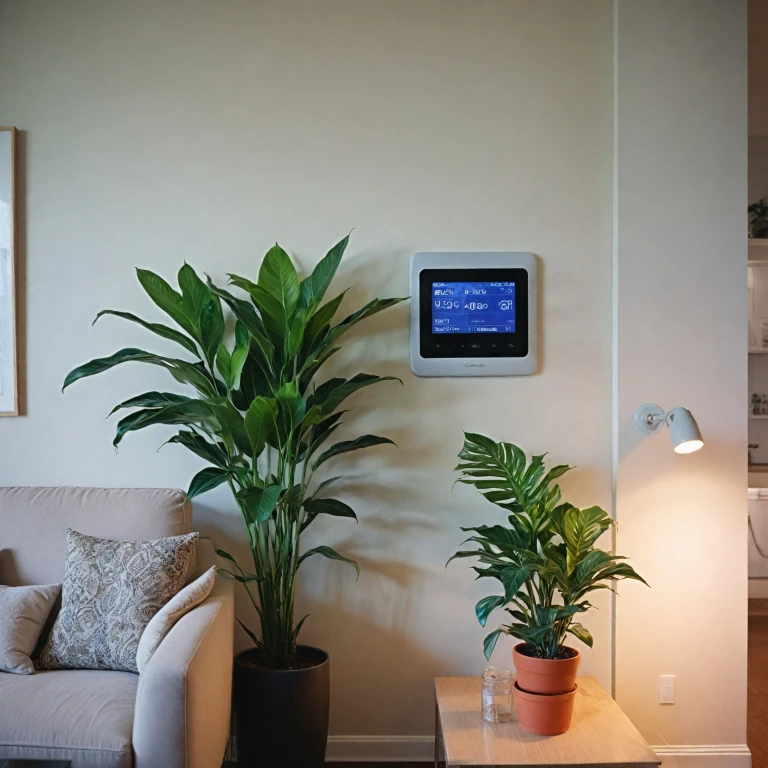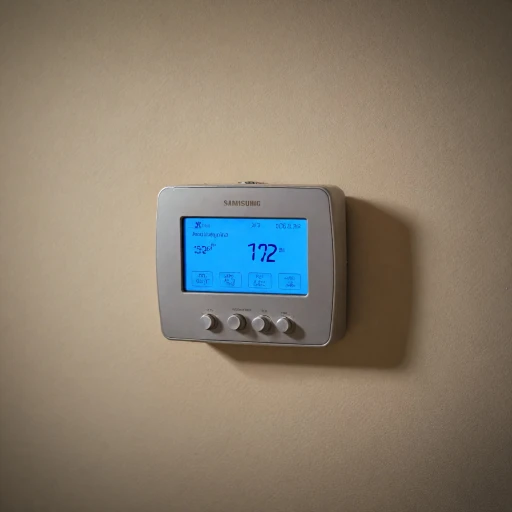Understanding Z-Wave Technology
Exploring Z-Wave Technology for Smart Thermostats
Z-Wave technology is increasingly becoming a preferred choice in home automation systems, particularly for smart thermostats. What makes Z-Wave attractive is its ability to create a reliable, low-power radio frequency (RF) mesh network that effectively connects various smart devices, including smart thermostats, across your home. When it comes to integrating smart thermostats, understanding the nuances of Z-Wave is crucial for maximizing the benefits of these devices. The essence of Z-Wave technology lies in its capability to enable two-way communication between devices, such as your programmable thermostat and HVAC systems. This interaction, often called a Z-Wave network, allows for real-time control and monitoring of your home's temperature settings. It provides a higher level of personalization and energy efficiency than traditional thermostats by reducing unnecessary energy consumption. Z-Wave devices, like a smart thermostat, operate on a Z-Wave network that typically uses frequencies that minimize interference with Wi-Fi or other household electronics. This is particularly significant for ensuring seamless integration and minimizing security risks. Security is a top concern for smart home systems; hence, Z-Wave devices adhere to robust encryption standards, providing peace of mind to users knowing their smart home system is secure.Unique Benefits of Z-Wave-Compatible Thermostats
One of the main attractions of using a Z-Wave thermostat is its ability to act as a hub within a sophisticated smart home system, interfacing with numerous other Z-Wave devices. This interconnectivity forms an integrated system where thermostats can ‘talk’ to lighting, smart locks, cameras, and other smart devices. Furthermore, programmable thermostats equipped with Z-Wave technology can be configured to handle stage heating and stage cooling, offering enhanced adaptability to varied climate control needs. The flexibility these devices offer, combined with their ability to operate over vast distances across Canada and Mexico, makes them an attractive option for diverse climatic regions. Another practical aspect of Z-Wave smart thermostats is their battery life efficiency. Compared to other smart thermostat versions, Z-Wave products are designed to optimize battery usage, ensuring prolonged operation without frequent replacements. Many Z-Wave thermostats also feature battery backup systems, maintaining operation even in the event of a power outage. For those interested in understanding the full scope of Z-Wave technology and its implications for smart heating systems, check out this enhancing comfort with smart heated floor thermostats for more in-depth information on integrating smart solutions in your home.Advantages of Using a Z-Wave Thermostat
Enhanced Temperature Control
Z-Wave thermostats bring a remarkable advancement in temperature management. By connecting to your home network, these devices offer seamless integration with your HVAC systems, providing precision control over stage heating and cooling. With a programmable thermostat feature, users can easily set schedules that align with their daily routines, enabling optimal energy use and comfort. This level of customization ensures that your home is always at the desired temperature, contributing to both energy efficiency and cost savings.Improved Energy Efficiency
Emphasizing energy conservation, Z-Wave thermostats are designed to minimize unnecessary energy use. By offering real-time data and detailed usage reports, the device helps users make informed decisions, reducing their carbon footprint and utility bills. The wave version of these thermostats integrates efficiently with other wave devices, creating a cohesive smart home ecosystem that elevates your energy management to a higher level.Seamless Connectivity
Z-Wave thermostats operate on the wave network, known for its reliability and security features. This network ensures that your smart thermostat remains robust and secure, avoiding interference from other wireless systems in your home. The wave smart technology also allows easy integration with existing security and automation components, giving you confidence in your connected home system.Long Battery Life and Pro Wave Features
With enhanced battery technology, Z-Wave thermostats offer extended battery life, ensuring that your home’s temperature control is uninterrupted. Additionally, pro wave features bring advanced capabilities, including remote control via mobile devices and compatibility with voice assistants. These features provide convenience and flexibility, allowing you to manage your home’s environment from anywhere, whether you're in Canada, Mexico, or elsewhere. For more insights into smart thermostats and how they integrate with different home environments, consider checking out this resource to see how various systems can be enhanced with smart technology. Z-Wave's security certification further ensures that your thermostat and associated devices operate safely within your home, securing your investment in smart home technology.Installation and Setup Guide
Step-by-Step Guide to Getting Started
When diving into the world of smart thermostats, particularly those utilizing Z-Wave technology, the installation and setup can seem daunting. But with careful planning, the incorporation of a Z-Wave thermostat into your home can be a straightforward process, enhancing the overall comfort and efficiency of your HVAC systems.Choosing the Right Z-Wave Thermostat
First, it’s crucial to select the appropriate Z-Wave product tailored to your needs, considering factors like your HVAC setup (whether you have standard or heat pump systems), and compatibility with existing systems. Many options exist within the Z-Wave series, with products offering features like programmable schedules, stage heating, and cooling controls.Gathering Necessary Tools and Materials
Before you begin, ensure you have the following tools and materials at hand:- Screwdriver
- Level
- Power drill (if required)
- Z-Wave thermostat device with compatible battery
- Access to the Z-Wave network and control device (like a smart hub)
- Internet access for any software updates and certifications
Installation Process
- Power Down Systems: Safety is paramount. Turn off power to your HVAC system at the circuit breaker to prevent any electrical mishaps.
- Remove Old Thermostat: Detach your existing thermostat, carefully noting the wiring connections. You may wish to label wires as a reference for the new installation.
- Mount the New Unit: Use the level to mount your Z-Wave thermostat ensuring it’s straight. Follow the manufacturer’s instructions for specific mounting steps.
- Connect Wiring: Attach the wires to the corresponding terminals on your new Z-Wave device. This stage requires ensuring each wire is securely fastened, supporting both heating and cooling stages.
- Install Batteries: Insert new batteries if your model uses them. A good battery life ensures continuous operation without frequent replacements.
- Power On and Test: Restore power and test the functionality. Press 'select' on your thermostat to access menu settings. Verify that the thermostat communicates effectively with your Z-Wave network.
Further Configurations and Fine-Tuning
Once installed, configure your thermostat settings. This may include setting up programmable schedules and integrating security measures within your Z-Wave network.Related Resources
For more detailed guidance on integrating smart thermostat technology, consider exploring the features of the TR7000T-50US smart thermostat which provides specific insights on advanced models. By following these steps, you can elevate your home's climate control to a higher level, maximizing efficiency and comfort with your Z-Wave thermostat.Comparing Z-Wave Thermostats to Other Smart Thermostats
Comparing Smart Thermostats: Z-Wave vs. Other Technologies
When it comes to smart thermostats, there are various technologies available, each with its own set of features and benefits. Z-Wave thermostats are a popular choice due to their unique capabilities. Let's explore how they stack up against other smart thermostat options.
Network Compatibility and Integration
Z-Wave thermostats are known for their compatibility with a wide range of smart home devices, thanks to the Z-Wave network. This allows for seamless integration with other Z-Wave products, creating a cohesive smart home system. In contrast, other smart thermostats often rely on Wi-Fi or proprietary networks, which might limit compatibility with non-native devices.
Security and Reliability
The security of your smart thermostat is paramount. Z-Wave technology offers a high level of security with its advanced encryption standards. This makes it a reliable choice for those concerned about data protection. Other smart thermostats may offer security features, but the Z-Wave certification ensures a consistent standard across devices.
Programmable Features and Control
Z-Wave thermostats often come with advanced programmable features, allowing users to set schedules and control HVAC systems with precision. While other smart thermostats also offer programmable options, the flexibility and customization available with Z-Wave devices can be a significant advantage, especially for those using multi-stage heating or cooling systems.
Battery Life and Power Options
Battery life is a crucial consideration for any smart device. Z-Wave thermostats typically offer efficient power management, ensuring longer battery life compared to some other smart thermostat versions. This is particularly beneficial in areas where power outages are common, as Z-Wave devices can maintain functionality without immediate power.
Future-Proofing and Updates
As smart home technology evolves, having a device that can keep up with new advancements is essential. Z-Wave's commitment to backward compatibility means that even older devices can integrate with newer Z-Wave series products. Other smart thermostats may require more frequent upgrades or replacements to stay current with the latest features.
In summary, while there are many smart thermostat options available, Z-Wave thermostats offer distinct advantages in terms of network integration, security, and future-proofing. This makes them a compelling choice for anyone looking to enhance their home's smart capabilities.
Troubleshooting Common Issues
Addressing Common Problems with Your Z-Wave Thermostat
While Z-Wave thermostats offer a range of benefits, like enhanced control over your HVAC systems and energy savings, users may occasionally encounter issues. Here’s a guide to troubleshooting some of the most common problems associated with these smart devices.
Connectivity Issues in the Z-Wave Network
One frequent issue is connectivity within the Z-Wave network. If your thermostat is not responding, it may have lost connection with the Z-Wave hub. Ensure that the thermostat is within range of the hub and that there are no obstructions causing interference. Rebooting the device or resetting the Z-Wave network can often resolve these issues.
Battery and Power Concerns
Battery life can affect the performance of your Z-Wave thermostat. If the device is battery-powered, check that the batteries are not depleted. For wired versions, ensure that the power supply is stable. Regular maintenance and timely replacement of batteries can prevent unexpected shutdowns.
Inconsistent Temperature Control
Inconsistent heating or cooling can be frustrating. This may be due to incorrect settings or a miscalibration of the thermostat. Double-check your programmable thermostat settings and ensure they align with your desired comfort levels. If using a multi-stage heating or cooling system, verify that the thermostat is compatible with your HVAC systems.
Software and Firmware Updates
Outdated software can lead to performance issues. Regularly check for firmware updates from the manufacturer to ensure your thermostat is running the latest version. These updates often include bug fixes and enhancements that improve the device’s functionality and security.
Security Concerns
As with any smart device, security is paramount. Ensure your Z-Wave thermostat is operating on a secure network. Utilize any available security features, such as encryption, to protect your device from unauthorized access.
By addressing these common issues, you can maintain the efficiency and reliability of your Z-Wave thermostat, ensuring a comfortable home environment year-round.
Future Trends in Smart Thermostat Technology
Emerging Trends in the World of Thermostats
As the smart thermostat market evolves, several intriguing trends are paving the way for the future of home climate control. Awareness of these trends can help you make informed decisions about your HVAC systems, ensuring you opt for a product that not only meets today's standards but is also ready for tomorrow's advancements.
One significant trend is the integration of advanced programmable features, which allow homeowners to enjoy unprecedented control over their heating and cooling. Thermostats are increasingly adopting new versions of Z-Wave technology, enabling more seamless integration with other smart home devices within the Z-Wave network. This wave of innovation affords consumers greater control and flexibility, setting the stage for improved energy efficiency and comfort.
With a growing emphasis on security, manufacturers are developing thermostats that prioritize data protection while maintaining the functionalities of traditional devices. The advent of two-stage heating and cooling capabilities, for instance, offers a refined approach to temperature management, aligning with more advanced HVAC systems.
In regions like Canada and Mexico, where market demands differ, smart thermostats are increasingly being designed to cater to higher-level requirements. These products are expected to exhibit prolonged battery life, essential for ensuring uninterrupted operation.
More and more, the emphasis is also on interoperable networks. Devices are being updated with higher wave certifications, allowing them to interface smoothly with other systems and programmable thermostats. This wave-smart interoperability is key to the evolving ecosystem of smart homes, fostering a streamlined experience for users across diverse environments.
Recognizing these trends, consumers can better navigate the market, optimizing their smart homes for both current convenience and future readiness.






